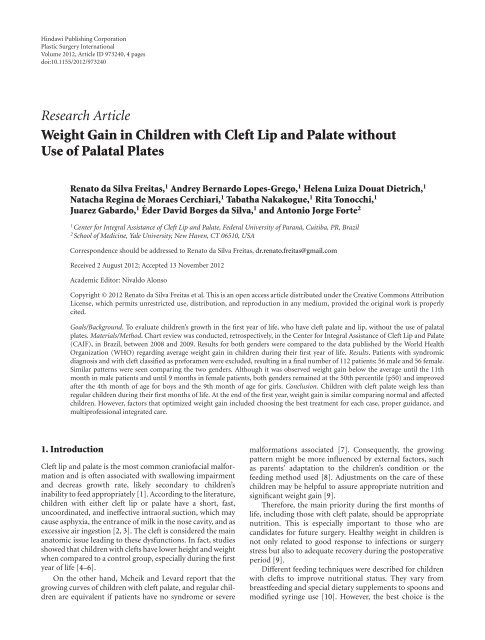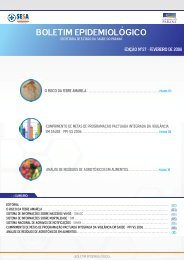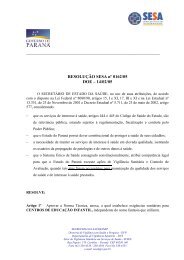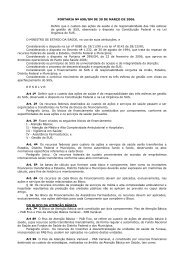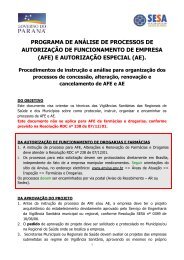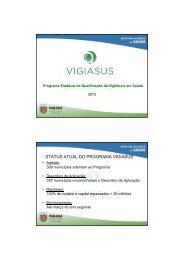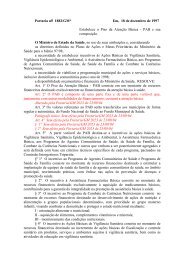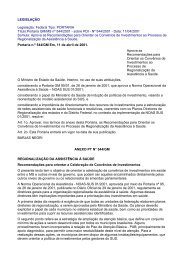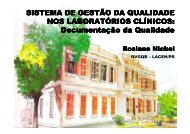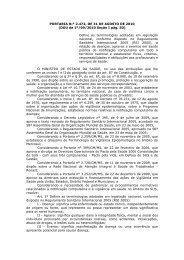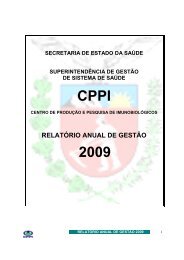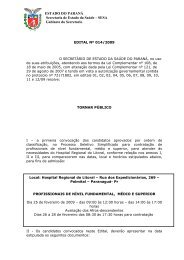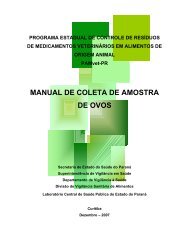Weight Gain in Children with Cleft Lip and Palate without Use of ...
Weight Gain in Children with Cleft Lip and Palate without Use of ...
Weight Gain in Children with Cleft Lip and Palate without Use of ...
You also want an ePaper? Increase the reach of your titles
YUMPU automatically turns print PDFs into web optimized ePapers that Google loves.
H<strong>in</strong>dawi Publish<strong>in</strong>g CorporationPlastic Surgery InternationalVolume 2012, Article ID 973240, 4 pagesdoi:10.1155/2012/973240Research Article<strong>Weight</strong> <strong>Ga<strong>in</strong></strong> <strong>in</strong> <strong>Children</strong> <strong>with</strong> <strong>Cleft</strong> <strong>Lip</strong> <strong>and</strong> <strong>Palate</strong> <strong>with</strong>out<strong>Use</strong> <strong>of</strong> Palatal PlatesRenato da Silva Freitas, 1 Andrey Bernardo Lopes-Grego, 1 Helena Luiza Douat Dietrich, 1NatachaReg<strong>in</strong>adeMoraesCerchiari, 1 Tabatha Nakakogue, 1 Rita Tonocchi, 1Juarez Gabardo, 1 Éder David Borges da Silva, 1 <strong>and</strong> Antonio Jorge Forte 21Center for Integral Assistance <strong>of</strong> <strong>Cleft</strong> <strong>Lip</strong> <strong>and</strong> <strong>Palate</strong>, Federal University <strong>of</strong> Paraná, Cuitiba, PR, Brazil2School <strong>of</strong> Medic<strong>in</strong>e, Yale University, New Haven, CT 06510, USACorrespondence should be addressed to Renato da Silva Freitas, dr.renato.freitas@gmail.comReceived 2 August 2012; Accepted 13 November 2012Academic Editor: Nivaldo AlonsoCopyright © 2012 Renato da Silva Freitas et al. This is an open access article distributed under the Creative Commons AttributionLicense, which permits unrestricted use, distribution, <strong>and</strong> reproduction <strong>in</strong> any medium, provided the orig<strong>in</strong>al work is properlycited.Goals/Background. To evaluate children’s growth <strong>in</strong> the first year <strong>of</strong> life, who have cleft palate <strong>and</strong> lip, <strong>with</strong>out the use <strong>of</strong> palatalplates. Materials/Method. Chart review was conducted, retrospectively, <strong>in</strong> the Center for Integral Assistance <strong>of</strong> <strong>Cleft</strong> <strong>Lip</strong> <strong>and</strong> <strong>Palate</strong>(CAIF), <strong>in</strong> Brazil, between 2008 <strong>and</strong> 2009. Results for both genders were compared to the data published by the World HealthOrganization (WHO) regard<strong>in</strong>g average weight ga<strong>in</strong> <strong>in</strong> children dur<strong>in</strong>g their first year <strong>of</strong> life. Results. Patients <strong>with</strong> syndromicdiagnosis <strong>and</strong> <strong>with</strong> cleft classified as preforamen were excluded, result<strong>in</strong>g <strong>in</strong> a f<strong>in</strong>al number <strong>of</strong> 112 patients: 56 male <strong>and</strong> 56 female.Similar patterns were seen compar<strong>in</strong>g the two genders. Although it was observed weight ga<strong>in</strong> below the average until the 11thmonth <strong>in</strong> male patients <strong>and</strong> until 9 months <strong>in</strong> female patients, both genders rema<strong>in</strong>ed at the 50th percentile (p50) <strong>and</strong> improvedafter the 4th month <strong>of</strong> age for boys <strong>and</strong> the 9th month <strong>of</strong> age for girls. Conclusion. <strong>Children</strong> <strong>with</strong> cleft palate weigh less thanregular children dur<strong>in</strong>g their first months <strong>of</strong> life. At the end <strong>of</strong> the first year, weight ga<strong>in</strong> is similar compar<strong>in</strong>g normal <strong>and</strong> affectedchildren. However, factors that optimized weight ga<strong>in</strong> <strong>in</strong>cluded choos<strong>in</strong>g the best treatment for each case, proper guidance, <strong>and</strong>multipr<strong>of</strong>essional <strong>in</strong>tegrated care.1. Introduction<strong>Cleft</strong> lip <strong>and</strong> palate is the most common crani<strong>of</strong>acial malformation<strong>and</strong> is <strong>of</strong>ten associated <strong>with</strong> swallow<strong>in</strong>g impairment<strong>and</strong> decreas growth rate, likely secondary to children’s<strong>in</strong>ability to feed appropriately [1]. Accord<strong>in</strong>g to the literature,children <strong>with</strong> either cleft lip or palate have a short, fast,uncoord<strong>in</strong>ated, <strong>and</strong> <strong>in</strong>effective <strong>in</strong>traoral suction, which maycause asphyxia, the entrance <strong>of</strong> milk <strong>in</strong> the nose cavity, <strong>and</strong> asexcessive air <strong>in</strong>gestion [2, 3]. The cleft is considered the ma<strong>in</strong>anatomic issue lead<strong>in</strong>g to these dysfunctions. In fact, studiesshowed that children <strong>with</strong> clefts have lower height <strong>and</strong> weightwhen compared to a control group, especially dur<strong>in</strong>g the firstyear <strong>of</strong> life [4–6].On the other h<strong>and</strong>, Mcheik <strong>and</strong> Levard report that thegrow<strong>in</strong>g curves <strong>of</strong> children <strong>with</strong> cleft palate, <strong>and</strong> regular childrenare equivalent if patients have no syndrome or severemalformations associated [7]. Consequently, the grow<strong>in</strong>gpattern might be more <strong>in</strong>fluenced by external factors, suchas parents’ adaptation to the children’s condition or thefeed<strong>in</strong>g method used [8]. Adjustments on the care <strong>of</strong> thesechildren may be helpful to assure appropriate nutrition <strong>and</strong>significant weight ga<strong>in</strong> [9].Therefore, the ma<strong>in</strong> priority dur<strong>in</strong>g the first months <strong>of</strong>life, <strong>in</strong>clud<strong>in</strong>g those <strong>with</strong> cleft palate, should be appropriatenutrition. This is especially important to those who arec<strong>and</strong>idates for future surgery. Healthy weight <strong>in</strong> children isnot only related to good response to <strong>in</strong>fections or surgerystress but also to adequate recovery dur<strong>in</strong>g the postoperativeperiod [9].Different feed<strong>in</strong>g techniques were described for children<strong>with</strong> clefts to improve nutritional status. They vary frombreastfeed<strong>in</strong>g <strong>and</strong> special dietary supplements to spoons <strong>and</strong>modified syr<strong>in</strong>ge use [10]. However, the best choice is the
2 Plastic Surgery Internationalone that the family <strong>and</strong> the child learn from providers whowork on reference centers [7]. One technique, <strong>in</strong>tend<strong>in</strong>g to<strong>in</strong>crease the suction <strong>of</strong> these patients, is the use <strong>of</strong> palatalplates. Palatal plates <strong>in</strong>tend to facilitate suction for thesepatients. Some authors also report that plates contribute toremodel the palatal arch, help<strong>in</strong>g <strong>in</strong>traoral suction dur<strong>in</strong>g thefirst months <strong>of</strong> life [11]. However, <strong>in</strong> our center, we do notuse palatal plates. Therefore, our study evaluates the growth<strong>of</strong> children <strong>with</strong> cleft palate <strong>and</strong> cleft lip <strong>in</strong> their first year <strong>of</strong>life, <strong>with</strong>out the use <strong>of</strong> palatal plates.2. MethodsThis study was approved by the Ethics <strong>in</strong> Research Committee<strong>of</strong> the Hospital de Clínicas from the Federal University <strong>of</strong>Paraná <strong>in</strong> Brazil, registration number: Banpesq 2012025932.Medical records from patients treated <strong>in</strong> the Center forIntegral Assistance <strong>of</strong> <strong>Cleft</strong> <strong>Lip</strong> <strong>and</strong> <strong>Palate</strong> (CAIF), <strong>in</strong> thecity <strong>of</strong> Curitiba, Brazil, dur<strong>in</strong>g the period from 2008 to 2009were carefully analyzed. All new cases <strong>of</strong> cleft lip, <strong>with</strong> cleftpalate associated <strong>and</strong> cleft palate isolated from patients underone year <strong>of</strong> age, were <strong>in</strong>cluded <strong>in</strong> this study. The data wasobta<strong>in</strong>ed retrospectively.The follow<strong>in</strong>g data po<strong>in</strong>ts were considered: (1) patient’sname, gender, <strong>and</strong> birth date; (2) cleft classification; (3) type<strong>of</strong> milk consumed: human breast milk, cows’ milk, or formula;(4) time length <strong>of</strong> exclusive breastfeed<strong>in</strong>g; (5) age <strong>of</strong>solid food consumption; (6) weight at birth; (7) monthlyweight dur<strong>in</strong>g the first year <strong>of</strong> life.The results found for boys <strong>and</strong> girls were then comparedto the data published by the World Health Organization(WHO) regard<strong>in</strong>g average weight ga<strong>in</strong> <strong>in</strong> children dur<strong>in</strong>gtheir first year <strong>of</strong> life.3. Results135 patients were <strong>in</strong>cluded <strong>in</strong> this study. Patients <strong>with</strong>syndromic diagnosis <strong>and</strong> <strong>with</strong> cleft classified as preforamenwere excluded, result<strong>in</strong>g <strong>in</strong> a f<strong>in</strong>al number <strong>of</strong> 112 patients: 56male <strong>and</strong> 56 female.Regard<strong>in</strong>g food type, the most prevalent was the use <strong>of</strong>nutritional formulas alone (36.6% <strong>of</strong> the sample), followedby the comb<strong>in</strong>ed use <strong>of</strong> breast milk <strong>and</strong> formula (25%).Exclusive use <strong>of</strong> breast <strong>and</strong> cow’s milk were 8.9% <strong>and</strong> 2.7%,respectively. The average duration <strong>of</strong> exclusive breastfeed<strong>in</strong>gwas 46 days, <strong>and</strong> the average age for <strong>in</strong>itiation <strong>of</strong> solid foodswas 8 months.Interest<strong>in</strong>gly, a similar weight ga<strong>in</strong> pattern was seen onboth genders. Figure 1 shows that the weight ga<strong>in</strong> <strong>in</strong> affectedmale patients is below the average for their age; by the 11thmonth, on the other h<strong>and</strong>, the curves were almost superimposed.At birth, the boy’s weight is about 200 g below theaverage for this age. This difference <strong>in</strong>creases as time goes by,reach<strong>in</strong>g almost 900 g <strong>in</strong> the third month <strong>of</strong> life; however,after the third month, the difference between the averageweight ga<strong>in</strong> beg<strong>in</strong>s to decrease. In fact, around the tenthmonth, affected <strong>in</strong>fants weight ga<strong>in</strong> exhibit a similar patternto normal.<strong>Weight</strong> (kg)1210864200 2 4 6 8 10 12Age (months)WHOStudy groupFigure 1: Comparison between the average weight ga<strong>in</strong> <strong>of</strong> boys <strong>with</strong>cleft lip <strong>and</strong> palate estimated by WHO. Blue dots: WHO; p<strong>in</strong>k dots:study group.<strong>Weight</strong> (kg)1210864200 2 4 6 8 10 12WHOStudy groupAge (months)Figure 2: Comparison between the average weight ga<strong>in</strong> <strong>of</strong> girls <strong>with</strong>cleft lip <strong>and</strong> palate estimated by WHO. Blue dots: WHO; p<strong>in</strong>k dots:study group.Figure 2 represents the weight ga<strong>in</strong> <strong>of</strong> female patientscompared <strong>with</strong> normal values. Girls weight ga<strong>in</strong> shows adifference <strong>of</strong> almost 200 g compared to the expected weightga<strong>in</strong>. There is a gradual <strong>in</strong>crease <strong>of</strong> this discrepancy up tothe third month <strong>of</strong> life, when it peaks at almost 750 g.Afterwards, the gap dim<strong>in</strong>ishes reach<strong>in</strong>g a similar patternnear the n<strong>in</strong>th month <strong>of</strong> life.
Plastic Surgery International 3<strong>Weight</strong> (kg)1210864200 1 2 3 4 5 6 7 8 9 10 11 12Age (months)p05 WHOp50 WHOp95 WHOAverage weight ga<strong>in</strong> boys—CAIFFigure 3: Curve <strong>of</strong> weight ga<strong>in</strong> for boys compared to percentilesestimated by WHO.<strong>Weight</strong> (kg)1210864200 1 2 3 4 5 6 7 8 9 10 11 12Age (months)p05 WHOp95 WHOp50 WHOAverage weight ga<strong>in</strong> girls—CAIFFigure 4: Curve <strong>of</strong> weight ga<strong>in</strong> for girls compared to percentilesestimated by WHO.<strong>Weight</strong> ga<strong>in</strong> curve <strong>in</strong> both genders, demonstrated <strong>in</strong>Figures 3 <strong>and</strong> 4, is plotted near the 50th percentile (p50) l<strong>in</strong>efor each time <strong>of</strong> assessment, cross<strong>in</strong>g it after the 4th month<strong>of</strong> age for boys <strong>and</strong> 9th months <strong>of</strong> age for girls.4. Discussion<strong>Children</strong> <strong>with</strong> clefts have a higher rate <strong>of</strong> malnutrition secondaryto suction<strong>in</strong>g impairment. This was first presentedby Fabricius <strong>and</strong> Aquapendente <strong>in</strong> 1916 [7]. S<strong>in</strong>ce then,multiple discussions about the actual <strong>in</strong>terference <strong>of</strong> clefts <strong>in</strong>growth rate <strong>and</strong> weight ga<strong>in</strong> have taken place [9].<strong>Weight</strong> ga<strong>in</strong> <strong>and</strong> grow<strong>in</strong>g becomes an issue dur<strong>in</strong>g thefirst month <strong>of</strong> life, probably due to their difficulty to generatenegative <strong>in</strong>traoral pressure, necessary to accomplish a goodsuction [12]. As a result, the process becomes quick, <strong>in</strong>efficient,<strong>and</strong> not coord<strong>in</strong>ated <strong>with</strong> the swell<strong>in</strong>g movements,that can result <strong>in</strong> <strong>in</strong>sufficient absorption <strong>of</strong> nutrients <strong>and</strong>deficiency <strong>in</strong> weight ga<strong>in</strong> [13]. In this context, the majority<strong>of</strong> children require some mechanical support to facilitate theflow <strong>of</strong> milk [10]. However, the most effective solution tothis problem is the palate corrective surgery, which occursbetween 9 <strong>and</strong> 12 months <strong>in</strong> most centers. The use <strong>of</strong>devices that facilitate suction <strong>and</strong> allow a greater <strong>in</strong>take<strong>of</strong> breast milk, such as the palatal plate, is an alternativeprotocol followed by some services [14, 15]. These centerspromote the benefits <strong>and</strong> advantages <strong>of</strong> palatal plate use.Consequently, some families <strong>and</strong> pediatricians question thechoice <strong>of</strong> not us<strong>in</strong>g it. Try<strong>in</strong>g to shed some light <strong>in</strong>to thisdiscussion, a r<strong>and</strong>omized study compared the weight ga<strong>in</strong><strong>and</strong> growth <strong>of</strong> children who used <strong>and</strong> did not use theprosthesis, f<strong>in</strong>d<strong>in</strong>g no statistically significant difference <strong>in</strong>the variables evaluated. For that reason, the research did notrecommend the universal use <strong>of</strong> the palatal plate [15].Another aspect widely discussed is the role played bydifferent nutritional formulas <strong>and</strong> the use <strong>of</strong> breast milkon the growth pattern <strong>and</strong> weight ga<strong>in</strong> <strong>in</strong> <strong>in</strong>fants <strong>with</strong> cleftpalate [16]. In our study, we did not identify any associationbetween the milk type <strong>and</strong> the weight ga<strong>in</strong> measured. Ourstudy noticed a predom<strong>in</strong>ant use <strong>of</strong> nutritional formulas,despite the policy <strong>of</strong> support<strong>in</strong>g breastfeed<strong>in</strong>g adopted byour hospital. This is probably due to the <strong>in</strong>tr<strong>in</strong>sic difficultyto collect breast milk <strong>and</strong> the convenience <strong>of</strong> formula use.Affected patients experience an obvious growth deficit <strong>in</strong>the early months <strong>of</strong> life <strong>in</strong> both genders. It is possible that thislower weight ga<strong>in</strong> dur<strong>in</strong>g this period is a consequence <strong>of</strong> cleft<strong>in</strong>fant’s adaptation to new methods <strong>of</strong> nutrition [17]. It isimportant to emphasize that, even though the <strong>in</strong>itial weightga<strong>in</strong> is lower than the one established by WHO (Figures 1<strong>and</strong> 2), the sample data is near to p50, especially the boys(Figures 3 <strong>and</strong> 4). Breastfeed<strong>in</strong>g is <strong>of</strong>ten hampered by the lack<strong>of</strong> knowledge <strong>of</strong> parents or caregivers about the proper ways<strong>of</strong> feed<strong>in</strong>g the cleft child <strong>and</strong> difficult access to appropriatetreatment centers for education <strong>and</strong> care.After patients’ <strong>in</strong>itial access to health care pr<strong>of</strong>essionals,it was noted improvement <strong>in</strong> growth <strong>and</strong> weight ga<strong>in</strong>, <strong>in</strong>dicat<strong>in</strong>gthat affected <strong>in</strong>fants, when appropriately stimulated toreach a targeted nutritional level, can achieve normal <strong>in</strong>fant’sgrowth. Therefore, proper orientation <strong>and</strong> access to followupare factors that contribute to improve patient’s nutritionalstatus [18]. <strong>Weight</strong> ga<strong>in</strong> greater than WHO’s mean percentileafter 10 months <strong>of</strong> age reaffirms the success <strong>of</strong> the currentfeed<strong>in</strong>g guidel<strong>in</strong>es, follow-up regimen <strong>and</strong> treatment.5. ConclusionIn our study, none <strong>of</strong> our cleft palate patients used palatalplates, <strong>and</strong> both genders weighed less than regular <strong>in</strong>fantsdur<strong>in</strong>g their first months <strong>of</strong> life, <strong>in</strong> comparison to the curvesestablished by the World Health Organization. However, atthe end <strong>of</strong> the first year, they presented similar weight ga<strong>in</strong><strong>in</strong> both groups. In addition, we noticed that the type <strong>of</strong>cleft palate <strong>and</strong> the type <strong>of</strong> milk consumed had no <strong>in</strong>fluence
4 Plastic Surgery Internationalneither on weight ga<strong>in</strong> nor on growth. Therefore, the factorsthat improved weight ga<strong>in</strong> were: choos<strong>in</strong>g the best treatmentfor each case, support, education, <strong>in</strong>tegrated multipr<strong>of</strong>essionalcare <strong>and</strong> regular follow<strong>in</strong>g up. Parents’ collaboration,work<strong>in</strong>g together <strong>with</strong> health pr<strong>of</strong>essionals, allowed adequategrow<strong>in</strong>g <strong>of</strong> cleft palate children, m<strong>in</strong>imiz<strong>in</strong>g health risks.Conflict <strong>of</strong> InterestsThe authors declare no conflict <strong>of</strong> <strong>in</strong>terests.References[1] C. Haberg, O. Larson, <strong>and</strong> J. Milerad, “Incidence <strong>of</strong> cleft lip<strong>and</strong> palate <strong>and</strong> risks <strong>of</strong> additional malformations,” <strong>Cleft</strong> <strong>Palate</strong>-Crani<strong>of</strong>acial Journal, vol. 35, no. 1, pp. 40–45, 1998.[2] K. Mizuno, A. Ueda, K. Kani, <strong>and</strong> H. Kawamura, “Feed<strong>in</strong>gbehaviour <strong>of</strong> <strong>in</strong>fants <strong>with</strong> cleft lip <strong>and</strong> palate,” Acta Paediatrica,International Journal <strong>of</strong> Paediatrics, vol. 91, no. 11, pp. 1227–1232, 2002.[3] M. C. Endriga, M. L. Speltz, C. L. Maris, <strong>and</strong> K. Jones, “Feed<strong>in</strong>g<strong>and</strong> attachment <strong>in</strong> <strong>in</strong>fants <strong>with</strong> <strong>and</strong> <strong>with</strong>out or<strong>of</strong>acialclefts,” Infant Behavior <strong>and</strong> Development, vol.21,no.4,pp.699–712, 1998.[4] I. N. Ize-Iyamu <strong>and</strong> B. D. Saheeb, “Feed<strong>in</strong>g <strong>in</strong>tervention <strong>in</strong>cleft lip <strong>and</strong> palate babies: a practical approach to feed<strong>in</strong>gefficiency <strong>and</strong> weight ga<strong>in</strong>,” International Journal <strong>of</strong> Oral <strong>and</strong>Maxill<strong>of</strong>acial Surgery, vol. 40, no. 9, pp. 916–919, 2011.[5] Y. A. Zarate, L. J. Mart<strong>in</strong>, R. J. Hopk<strong>in</strong>, P. L. Bender, X. Zhang,<strong>and</strong> H. M. Saal, “Evaluation <strong>of</strong> growth <strong>in</strong> patients <strong>with</strong> isolatedcleft lip <strong>and</strong>/or cleft palate,” Pediatrics, vol. 125, no. 3, pp.e543–e549, 2010.[6] I. L. Marques, J. A. Nackashi, H. C. Borgo et al., “Longitud<strong>in</strong>alstudy <strong>of</strong> growth <strong>of</strong> children <strong>with</strong> unilateral cleft-lip palate frombirth to two years <strong>of</strong> age,” <strong>Cleft</strong> <strong>Palate</strong>-Crani<strong>of</strong>acial Journal, vol.46, no. 6, pp. 603–609, 2009.[7] J. N. Mcheik <strong>and</strong> G. Levard, “Growth <strong>in</strong> <strong>in</strong>fants <strong>in</strong> the firsttwo years <strong>of</strong> life after neonatal repair for unilateral cleft lip <strong>and</strong>palate,” International Journal <strong>of</strong> Pediatric Otorh<strong>in</strong>olaryngology,vol. 74, no. 5, pp. 465–468, 2010.[8] L. C. Montagnoli, M. A. Barbieri, H. Bettiol, I. L. Marques,<strong>and</strong>L.deSouza,“Prejuízo no crescimento de crianças comdiferentes tipos de fissura lábio-palat<strong>in</strong>a nos dois primeirosanos de idade. Um estudo transversal,” Journal <strong>of</strong> Pediatrics,vol. 81, no. 6, pp. 461–465, 2005.[9] D. A. Redford-Badwal, K. Mabry, <strong>and</strong> J. D. Frass<strong>in</strong>elli, “Impact<strong>of</strong> cleft lip <strong>and</strong>/or palate on nutritional health <strong>and</strong> oral-motordevelopment,” Dental Cl<strong>in</strong>ics <strong>of</strong> North America, vol. 47, no. 2,pp. 305–317, 2003.[10] M. A. Darzi, N. A. Chowdri, <strong>and</strong> A. N. Bhat, “Breast feed<strong>in</strong>g orspoon feed<strong>in</strong>g after cleft lip repair: a prospective, r<strong>and</strong>omisedstudy,” British Journal <strong>of</strong> Plastic Surgery, vol. 49, no. 1, pp. 24–26, 1996.[11] C. Prahl, A. M. Kuijpers-Jagtman, M. A. Van’t H<strong>of</strong>, <strong>and</strong> B.Prahl-Andersen, “Infant orthopedics <strong>in</strong> UCLP: effect on feed<strong>in</strong>g,weight, <strong>and</strong> length: a r<strong>and</strong>omized cl<strong>in</strong>ical trial (Dutchcleft),”<strong>Cleft</strong> <strong>Palate</strong>-Crani<strong>of</strong>acial Journal, vol. 42, no. 2, pp. 171–177, 2005.[12] S. Am<strong>in</strong>pour <strong>and</strong> T. T. Tollefson, “Recent advances <strong>in</strong> presurgicalmold<strong>in</strong>g <strong>in</strong> cleft lip <strong>and</strong> palate,” Current Op<strong>in</strong>ion <strong>in</strong>Otolaryngology <strong>and</strong> Head <strong>and</strong> Neck Surgery, vol.16,no.4,pp.339–346, 2008.[13] L. G. Amstalden-Mendes, L. A. Magna, <strong>and</strong> V. L. Gil-da-Silva-Lopes, “Neonatal care <strong>of</strong> <strong>in</strong>fants <strong>with</strong> cleft lip <strong>and</strong>/orpalate: feed<strong>in</strong>g orientation <strong>and</strong> evolution <strong>of</strong> weight ga<strong>in</strong> <strong>in</strong>a nonspecialized Brazilian hospital,” <strong>Cleft</strong> <strong>Palate</strong>-Crani<strong>of</strong>acialJournal, vol. 44, no. 3, pp. 329–334, 2007.[14] M. L. Cunn<strong>in</strong>gham <strong>and</strong> J. T. Jerome, “L<strong>in</strong>ear growth characteristics<strong>of</strong> children <strong>with</strong> cleft lip <strong>and</strong> palate,” Journal <strong>of</strong> Pediatrics,vol. 131, no. 5, pp. 707–711, 1997.[15] L. V. Avedian <strong>and</strong> R. L. Ruberg, “Impaired weight ga<strong>in</strong> <strong>in</strong> cleftpalate <strong>in</strong>fants,” <strong>Cleft</strong> <strong>Palate</strong> Journal, vol. 17, no. 1, pp. 24–26,1980.[16] J. Reid, “A review <strong>of</strong> feed<strong>in</strong>g <strong>in</strong>terventions for <strong>in</strong>fants <strong>with</strong>cleft palate,” <strong>Cleft</strong> <strong>Palate</strong>-Crani<strong>of</strong>acial Journal, vol.41,no.3,pp. 268–278, 2004.[17] E. B. Silva, C. L. B. Fúria, <strong>and</strong> C. Q. M. S. Di N<strong>in</strong>no, “Aleitamentomaterno em recém nascidos portadores de fissuralabiopalat<strong>in</strong>a: dificuldades e métodos utilizados,” RevistaCEFAC, vol. 7, no. 1, pp. 21–28, 2005.[18] N. H. Rob<strong>in</strong>, H. Baty, J. Frankl<strong>in</strong> et al., “The multidiscipl<strong>in</strong>aryevaluation <strong>and</strong> management <strong>of</strong> cleft lip <strong>and</strong> palate,” SouthernMedical Journal, vol. 99, no. 10, pp. 1111–1120, 2006.


